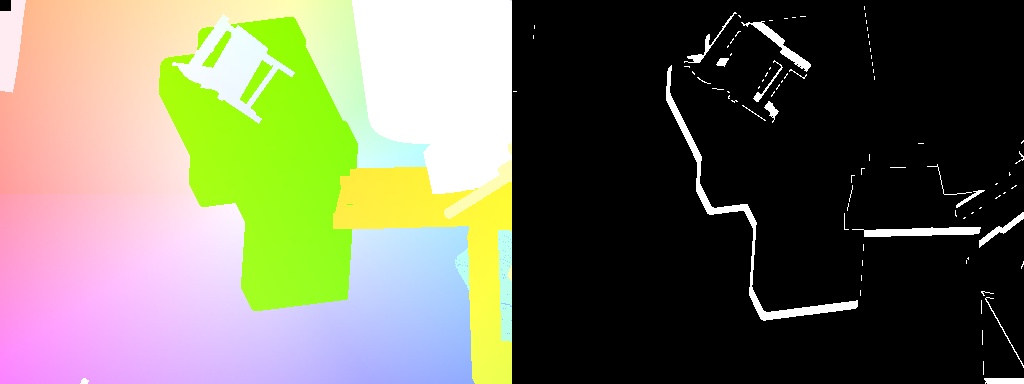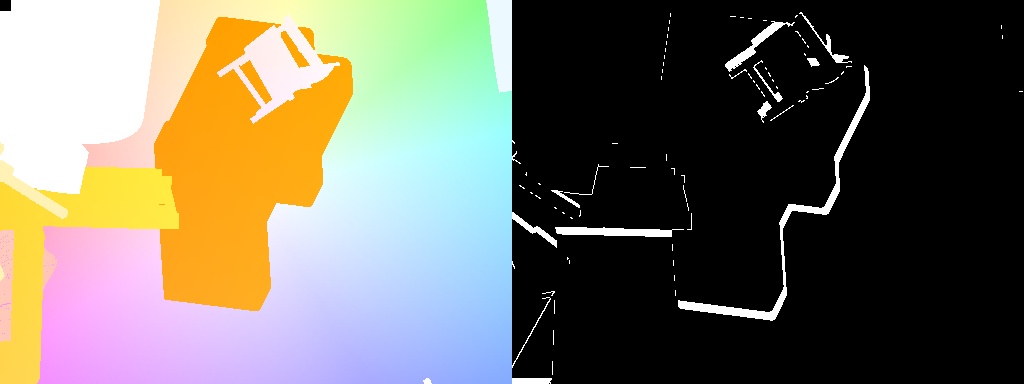Flow¶
The aloscene Flow object represents a 2D Optical Flow Map.
Basic Use¶
Creating a Flow object¶
A Flow object can be initialized from a path to a flow file:
from aloscene import Flow
flow = Flow("path/to/flow.flo")
or from an existing tensor:
import torch
flow_tensor = torch.zeros((2,400,600))
flow = Flow(flow_tensor, names=("C","H","W"))
An occlusion mask can be attached to the Flow during its creation:
from aloscene import Mask
occlusion = Mask(torch.zeros(1,400, 600), names=("C","H","W"))
flow = Flow("path/to.flow.flo", occlusion)
Or later:
flow.append_occlusion(occlusion)
Easy visualization¶
With aloscene API, it is really straigthforward to visualize data. In one line of code,
you can get a RGB view of a Flow object and its occlusion map and display it:
from alodataset import ChairsSDHomDataset
# read flow data
dataset = ChairsSDHomDataset(sample=True)
frame = next(iter(dataset.stream_loader()))
flow = frame[0].flow["flow_forward"]
# visualize it
view = flow.get_view() # view containing a numpy array with RGB data
view.render() # render with matplotlib or cv2 and show data in a new window

Visualization of an optical flow sample from ChairsSDHomDataset.¶
Easy transformations¶
With aloscene API, it is easy to apply transformations to visual data, even when it necessitate extra care.
For example, horizontally flipping a frame with flow data is usually tedious. The image, the flow and the occlusion should be flipped. But the flow necessitate a specific transformation: the values of the vectors must be modified, in addition to changing their coordinates in the tensor.
With aloscene API, this is done automatically in one function call:
frame_flipped = frame.hflip() # flip frame and every attached labels
flow_flipped = frame_flipped[0].flow["flow_forward"]
flow_flipped.get_view().render() # display flipped flow and occlusion

Visualization of the previous flow sample, after horizontal flip. The colors are different, because flow vectors values have been correctly modified. The occlusion has also been flipped.¶
Flow API¶
- class aloscene.flow.Flow(x, occlusion: Optional[aloscene.mask.Mask] = None, *args, names=('C', 'H', 'W'), **kwargs)¶
Bases:
aloscene.tensors.spatial_augmented_tensor.SpatialAugmentedTensorOptical Flow Map.
- Parameters
- xstr or tensor
path to a flow file (“.flo”) or flow tensor
- occlusionaloscene.Mask
occlusion mask attached to flow map
- append_occlusion(occlusion, name=None)¶
Attach an occlusion mask to the frame.
- Parameters
- occlusion: aloscene.Mask
Occlusion mask to attach to the Frame
- name: str
If none, the occlusion mask will be attached without name (if possible). Otherwise if no other unnamed occlusion mask are attached to the frame, the mask will be added to the set of mask.